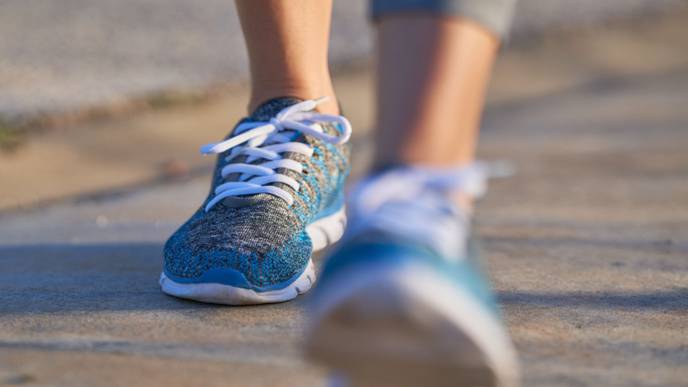Smartphone Tech Reveals Gait Differences in Duchenne Muscular Dystrophy

03/04/2024
Smartphone technology was able to capture gait characteristic differences between adolescents who have Duchenne muscular dystrophy (DMD) and their typically developing (TD) counterparts, according to a new investigation that utilized the waist-worn NGN Sport fitness phone belt to carry an Apple iPhone 11—which includes a single, built-in triaxial accelerometer—and the Walk4Me app developed by the investigators to collect data on vertical, mediolateral, and anteroposterior acceleration.
Published in Sensors (Basel), this investigation included 2 matched groups of 15 male children each aged 3 to 16 years (DMD or TD) with at least 6 months of walking experience, who participated in 8 walking/running (gait) activities in this order:
The male patients in this analyses were aged 3 to 16 years
Image credit: WavebreakmediaMicro - stock.adobe.com
- 25-m slowest-speed speed-calibration-L1 (SC-L1)
- 25-m slow walk (SC-L2)
- 25-m self-selected walk pace (SC-L3)
- 25-m fast walk (SC-L4)
- 25-m run or fastest possible gait (SC-L5)
- 6-minute walk test (6MWT)
- 100-m fast walk/jog/run (100MRW)
- Free walk via Northstar Ambulatory Assessment (NSAA)
Patients in the DMD group were older (mean [SD] age, 9.5 [3.9] vs 7.7 [3.0] years, had a higher weight (37.7 vs 34.2 kg), and were shorter (127.1 vs 130.8 cm). Also, their mean NSAA score (out of a maximum of 34) was lower compared with the TD group: 20.5 (8.2) vs 33.8 (0.8) in the TD group.
Overall, for temporospatial gait clinical features, for the slower-paced tests (SC-L1 and SC-L2), step length (percentage of standing height) and walking speed (meters/second normalized by height in meters) measures were significantly lower, and percent of accelerations significantly higher among the children with DMD. For the faster-paced tests (free walk, SC-L3, SC-L4, and 6MWT), the participants with DMD had a lower percentage of vertical accelerations. And with the faster jogging/running paces (SC-L5 and 100MRW), the children with DMD had a much lower step frequency (steps/second):
- SC-L1:
- Step length: 0.23% vs 0.27%
- Walking speed: 0.26% vs 0.35%
- SC-L2:
- Step length: 0.29% vs 0.34%
- Walking speed: 0.46% vs 0.55%
- Free walk: 32.87% vs 41.38%
- SC-L3: 30.16% vs 36.93%
- SC-L4: 29.07% vs 38.92%
- 6MWT: 31.61% vs 41.68%
- SC-L5: 2.82 vs 3.61
- 100MRW: 2.57 vs 3.39
The study authors also used classical machine learning (CML-CF) and deep learning (DL-RAW) approaches on their data to differentiate between children who had DMD and those who did not. These 2 approaches were used on the data from all 8 gait activities.
The highest accuracy score of 100% was seen when the investigators used the CML-CF approach to assess the data from the SC-L3 (25-m self-selected walk pace). In comparison, the highest accuracy score for the DL-RAW approach was 86.67% for the SC-L2 (25-m slow walk) and FW tests.
Speaking to the differences seen with these learning approaches, the study authors noted that the CML-CF approach uses more all-encompassing clinical data on participants—speed, step length, age, height, and weight—whereas the DL-RAW approach uses only raw accelerometer data and lacks the ability to extract speed and step length.
An additional analysis compared step length, gait speed, and functional ability between the DMD and TD groups using the NSAA to see how step-length measures relate to patient clinical features. The highest-functioning children with DMD still had significant step length reductions vs the TD cohort—except at the lowest slow walking speed.
“Use of ubiquitous and widely available mobile devices with single accelerometers to remotely measure differences in common clinical gait parameters represents an opportunity to expand the study of temporospatial gait characteristics into the community setting,” the study authors concluded. “Extension of measurement of ambulatory capacity into the community setting will provide clinicians and researchers with tools that assess changes in patient mobility in real-world conditions against a background of habitual daily activities, seasonal variations, and the built environment.”
Still, they underscore the importance of ongoing studies to improve predictive accuracy and identify additional clinical parameters (eg, growth, gait impairment, disease progression) that can help to clarify the course of neuromuscular diseases.
Reference
Ramli RA, Liu X, Berndt K, et al. Gait characterization in Duchenne muscular dystrophy (DMD) using a single-sensor accelerometer: classical machine learning and deep learning approaches. Sensors (Basel). 2024;24(4):1123. doi:10.3390/s24041123

Facebook Comments